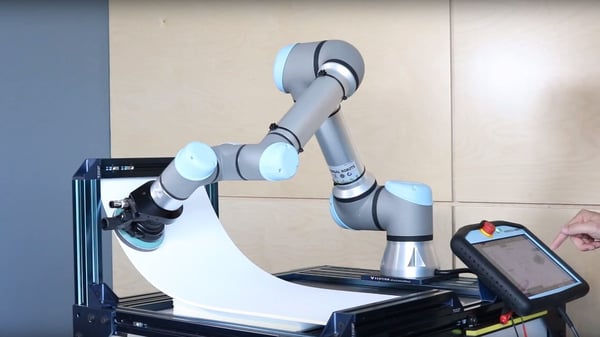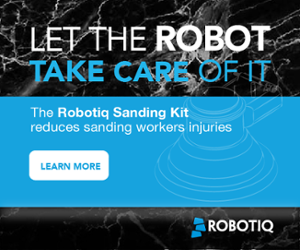5 Questions to Ask Yourself Before Using Robot Finishing

Posted on Jul 04, 2019 in Robotics, Robots
5 min read time
Are you thinking of choosing collaborative robot sanding or polishing? Stop!… and first, ask yourself these 5 questions.
 Robotiq's Sanding Kit - Effortless automation, consistent force
Robotiq's Sanding Kit - Effortless automation, consistent force
There are many good reasons that you might decide to choose a collaborative robot for your finishing tasks. Compared to manual sanding and polishing, robots improve consistency, reduce boredom, and increase the productivity of these dull-but-vital finishing tasks.
Even so, although there are great reasons for choosing this new technology it's always worth asking yourself some fundamental questions before you take the big leap.
Here are 5 important questions to ask yourself before you make your final decision about robot finishing.
1. What's my performance goal for this application?
Whenever you add a new technology to your business, it's always a good idea to take a step back and ask yourself "What will success look like if this goes well?" Clarifying your intended performance goals is a great way to do this.
In manufacturing, we often think about performance goals as being "hard" production metrics like throughput, downtime, etc. However, when it comes to robotic finishing, the performance improvements could reach much further than just cold numbers.
For example, giving a boring sanding task to a robot will free up a member of your team to do more interesting, intrinsically rewarding tasks. This could raise the performance of that team member, not just because they can be moved to more value-added tasks but also because they will be more motivated when their job is interesting.
It is often useful to define your performance goals with specific Key Performance Indicators (KPIs). Check out our eBook for an introduction to cobot KPIs.
2. Why am I considering robot finishing?
It may seem like an obvious question to you, but why are you doing finishing at all?
And what has prompted you to think that robotics will be the right solution?
There are all sorts of reasons that people might choose robotic finishing. Some reasons are good, some are not so good. An example of a great reason could be something like "Our sanding operators are developing wrist problems and we want to improve their quality of work and productivity by automating." An example of a not-so-good reason might be "I read about robot sanding in a magazine and it looks cool."
List all of the potential reasons that robotic finishing might be good for your business. Then, pick the top 1-5 reasons and try to assign one or more KPIs to each.
This will help you to clarify exactly what you want to achieve with robot finishing and help you to consider all of the potential solutions.
3. What type(s) of finishing do I require?
Our cobot finishing kit is called a "Sanding Kit", but don't let the name fool you. There are various types of finishing and the kit is compatible with a few of them.
The main types of finishing are: sanding, polishing, and buffing. The distinctions between these are blurry, but in general each of them describes a less aggressive amount of material removal. Sanding is the most aggressive and buffing is the least aggressive. See this article for more specifics about the different types of finishing.
The type of finishing will also determine the type of abrasive you need to choose.
There is likely to be more than one feasible solution for automating your finishing task. For example, there are at least 3 ways to automate sanding tasks. Not all of the solutions will involve a robot, but you should consider them anyway to ensure you are truly picking the right solution for your unique situation.
4. How often will I need to change the abrasive?
Unlike many other robot applications, finishing usually requires at least some human intervention when it's time to change the abrasive.
Sanding abrasives can wear down very quickly with some jobs. If yours needs to be replaced often, the advantages of using a robot can soon be displaced by the disadvantages of replacing the sanding disk all the time.
Unfortunately, there's no quick and easy way to calculate how often you will have to change your finishing abrasive. There are several equations to calculate the wear rate and/or the wear coefficient of a material but they are probably too complex to be useful in most cases.
A good way to estimate the wear rate of your abrasive is to look at how often your operators currently change their abrasives. However, even if your abrasive currently has a high wear rate remember that you can always choose a longer-wearing abrasive. Also, robot finishing can prolong the life of the abrasive compared to manual finishing because robots apply a consistent force.
5. How will I communicate the benefits to my team?
The final question you need to ask yourself has nothing to do with the robotic technology itself, but it will have a huge effect on the success of your robot integration.
If you have read through this article, you are probably already quite convinced of the benefits of robot finishing. However, you are not the only person who will be affected by the introduction of a finishing robot to your business. Other members of your team don't necessarily have the same information that you have.
Be sure to clarify the benefits of the robot in ways that your whole whole team can understand. Think about what is important to each person in your team and try to highlight specific advantages that they will appreciate.
There is often resistance when you first introduce robots to a workfloor. But, with the right approach, everyone on the team will be as enthusiastic as you are about robot finishing!
Which vital question do you think have we have missed out of this list? Tell us in the comments below or join the discussion on LinkedIn, Twitter, Facebook or the DoF professional robotics community.









Leave a comment